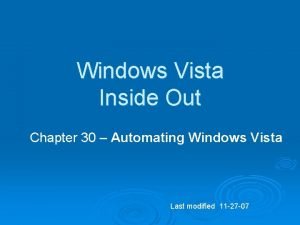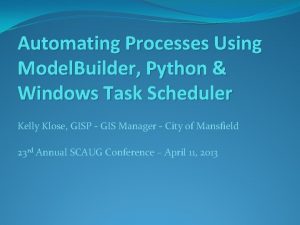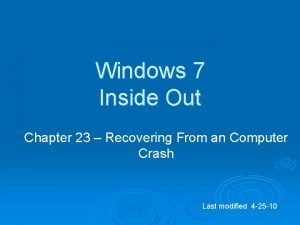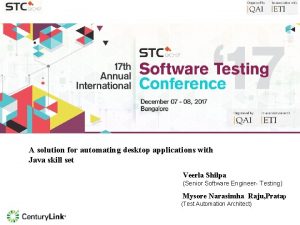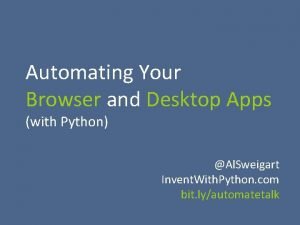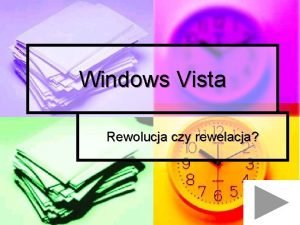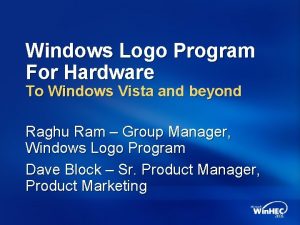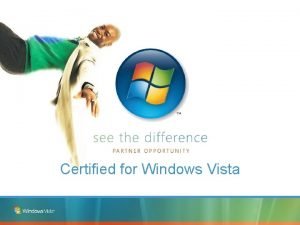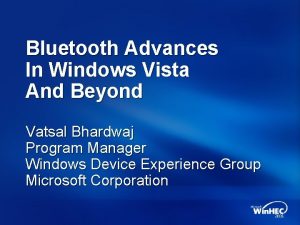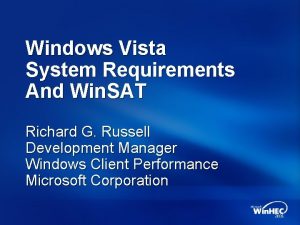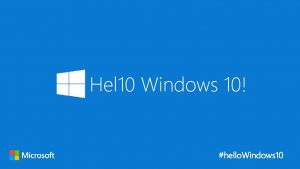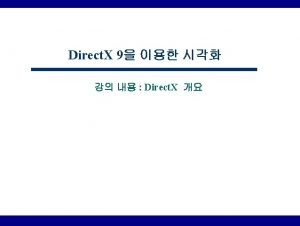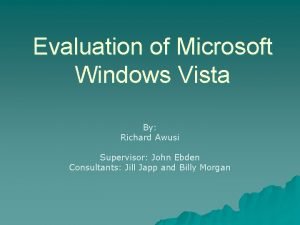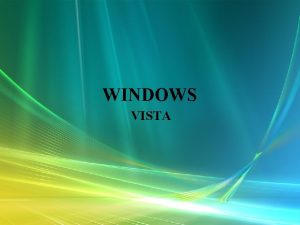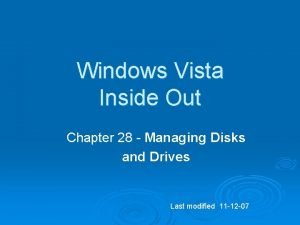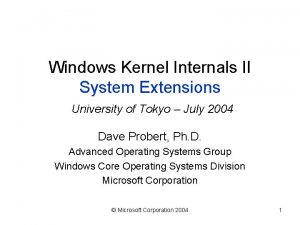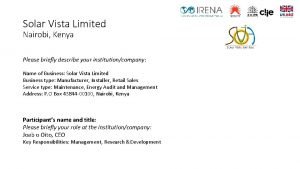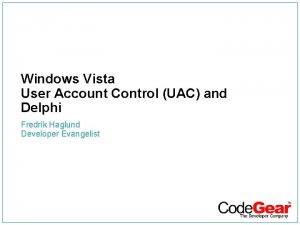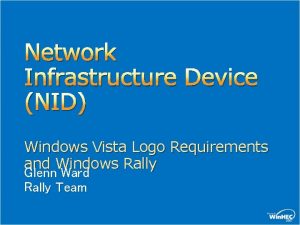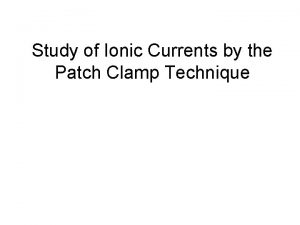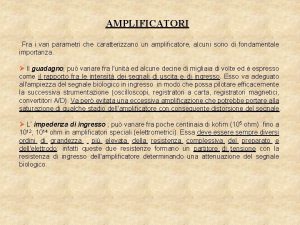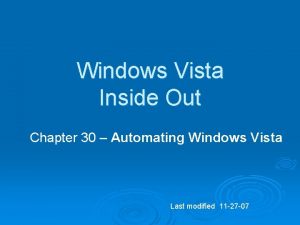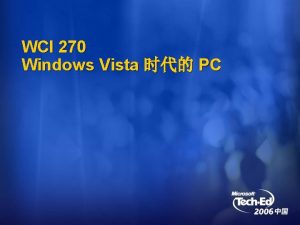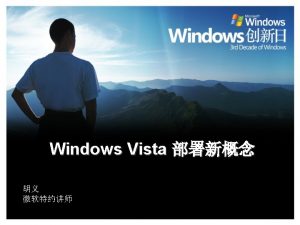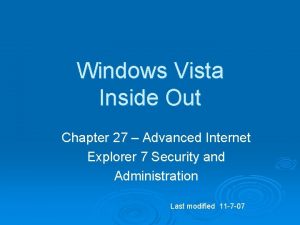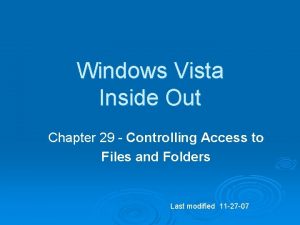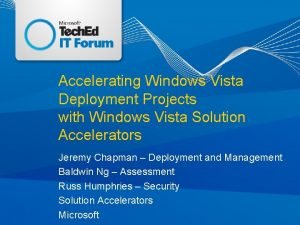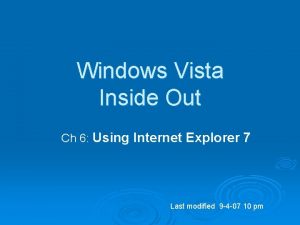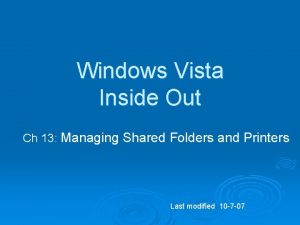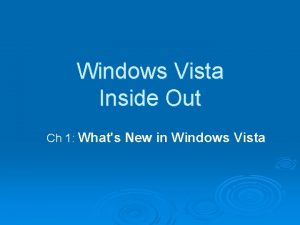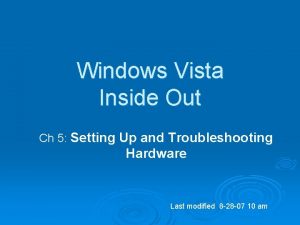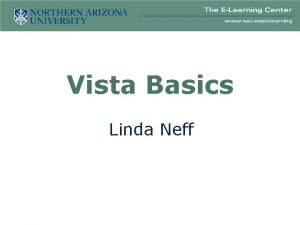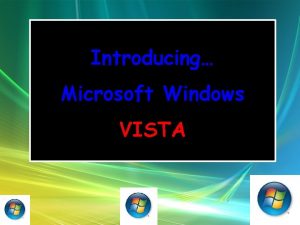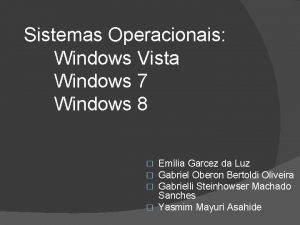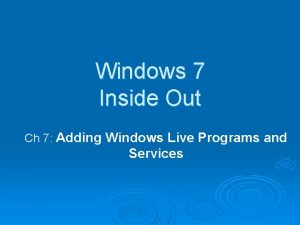Windows Vista Inside Out Chapter 30 Automating Windows



































- Slides: 35

Windows Vista Inside Out Chapter 30 – Automating Windows Vista Last modified 11 -27 -07

Editions Ø The Automation Tools are the same in all editions of Windows Vista

Four Ways to Automate Tasks Ø Task Scheduler l Ø Batch Programs l Ø Carried over from MS-DOS Windows Script Host l Ø Easiest and simplest Can run scripts written in VBScript, JScript, and other languages Windows Power. Shell l l Not included in Vista by default A free download from Microsoft

We Only Cover Task Scheduler Ø The other three methods are not part of this class: l l l Batch Programs Windows Script Host Windows Power. Shell

New Features in Task Scheduler Ø Implemented as a Microsoft Management Console (MMC) snap-in l More information about tasks Ø Integrated with the Event Viewer l Events can trigger tasks Ø More extensive triggering and scheduling options l l Launch when computer is idle Launch when a specific user logs on

Launching Task Scheduler Ø Control Panel, System And Maintenance, Scroll to bottom, under Administrative Tools, Schedule Tasks Ø Or taskschd. msc at a Command Prompt Ø Or Start, search for "Task Scheduler"

Task Scheduler Window Ø View, Customize, and then deselect Action Pane Ø To update, Action, Refresh

Display All Running Tasks Ø Select top node in left pane Ø Action, Display All Running Tasks

Task Details Ø Browse to task in folder tree to see read- only details in lower pane Ø To modify them, right-click task name in the top pane and click Properties

Task Scheduler Terminology Ø Trigger l The time or the event that causes a task to run Ø Action l What the task does Ø Condition l An additional requirement that, along with the trigger, must be met for the task to run Ø Setting l A property that affects the behavior of a task

Demonstration: System Restore Ø See when Restore Points were made

Scheduling Tasks with the Schtasks Command Ø Schtasks /Create Ø Schtasks /Change Ø Schtasks /Delete Ø Schtasks /End Ø Schtasks /Query Ø Schtasks /Run

Windows Vista Inside Out Chapter 31 – Advanced Security Management

Topics Ø Windows Firewall With Advanced Security Ø User Rights Ø Auditing

Editions Ø Windows Firewall With Advanced Security is the same in all editions of Windows Vista Ø User rights are the same in all Editions l But the console for viewing and modifying them is available only in the Business, Enterprise, and Ultimate editions

Editions Ø Auditing is preconfigured and cannot be changed in the home editions l The other editions allow you to control exactly what you audit

Protecting a System with Windows Firewall Ø For basic control, use Windows Firewall application in Control Panel Ø For more advanced tasks, use: l l Windows Firewall With Advanced Security, or The Netsh command-line utility

To Open Windows Firewall with Advanced Security Ø Start, FIRE l or Ø wf. msc l at a command prompt

Viewing Active Rules and Security Ø A firewall rule defines how a given network packet is handled by the Windows Firewall Ø Exceptions in Windows Firewall comprise one of more rules

Inbound Rules Ø There a lot of rules Ø You can make custom rules if you like (see textbook)

Demonstration Ø Restricting Remote Desktop to LAN connections Ø Double-click "Remote Desktop (TCP-In)

Demonstration Ø On the Advanced tab, click Customize Ø Select desired interface types

Logging Firewall Activity Ø Right-click the top- level folder: l Windows Firewall With Advanced Security On Local Computer Ø Properties Ø Choose the desired profile's tab l Domain, Private, or Public

Firewall Log Ø To view the log, you need an elevated Notepad window

Logging Settings Ø In the Logging section, click Customize Ø Logging successful packets is usually worthless—too much boring data

Using the Netsh Command to Manage Windows Firewall Ø You can enable Windows Firewall with this command: l netsh firewall set opmode enable Ø There a lot of netsh commands, to use some of them, do the Server Core project

Testing Your Computer’s Network Security Ø To see the currently active network connections, at a Command Prompt: l netstat -a | more Ø You could just use netstat –a, but it would scroll off the screen Ø This command uses numbers instead of DNS names, and shows process IDs: l netstat -aon | more

Correlating Process IDs Ø Netstat shows the PID that is listening Ø Task Manager shows the process

Managing User Rights Ø A user right is authorization to perform an operation that affects an entire computer Ø A permission, is authorization to perform an operation on a specific object—such as a file or a folder

Local Security Policy Ø Available only on Business, Enterprise, or Ultimate editions of Vista. Ø At a command prompt, type secpol. msc

Default User Rights Ø These User Rights are what makes an Administrator different from a User Ø It is not common to change them from their default settings Ø You could change "Bypass Traverse Checking" to prevent security problems in nested folders

Auditing Security Events Ø Auditing writes events into the Security Log, when l l l A monitored folder is accessed Logon or Logoff Many other possibilities

Enabling Auditing Ø Before any events can be written to the Security log, you must enable Auditing in Local Security Settings Ø Enable the desired auditing

Monitoring Access to Folders and Files Ø Right-click file or folder, Properties, Security tab, Advanced, Auditing tab Ø Add, Everyone Ø Check events to audit

Security Events Ø Now you will see a LOT of events from the auditing
 Windows 7 inside out
Windows 7 inside out Python windows desktop automation
Python windows desktop automation Windows vista windows 10
Windows vista windows 10 Windows 7 inside out
Windows 7 inside out Proyecciones en sistema europeo y americano
Proyecciones en sistema europeo y americano Songs with literary devices
Songs with literary devices Java desktop application automation testing
Java desktop application automation testing Desktop automation using python
Desktop automation using python Windows vista kernel
Windows vista kernel Logo windows vista
Logo windows vista Win vista requirements
Win vista requirements Bluetooth for windows vista
Bluetooth for windows vista Winsat formal -restart clean
Winsat formal -restart clean Windows codename longhorn
Windows codename longhorn Hello windows vista
Hello windows vista Vk_prior
Vk_prior Windows vista
Windows vista Windows vista je
Windows vista je Windows vista ui
Windows vista ui Windows vista disk management
Windows vista disk management Windows vista kernel extension
Windows vista kernel extension Vista windows kenya
Vista windows kenya Delphi manifest
Delphi manifest Windows vista tour
Windows vista tour Windows vista logo
Windows vista logo Net framework windows vista 32 bit
Net framework windows vista 32 bit Patch clamp inside out
Patch clamp inside out Instinct theory inside out
Instinct theory inside out Inside out by francisco jiménez
Inside out by francisco jiménez Inside out vocabulary
Inside out vocabulary Mothering from the inside out
Mothering from the inside out Inside out patch clamp
Inside out patch clamp Inside out
Inside out Organizing from the inside out
Organizing from the inside out Inside out guessing the feelings
Inside out guessing the feelings Inside out idea generation
Inside out idea generation
